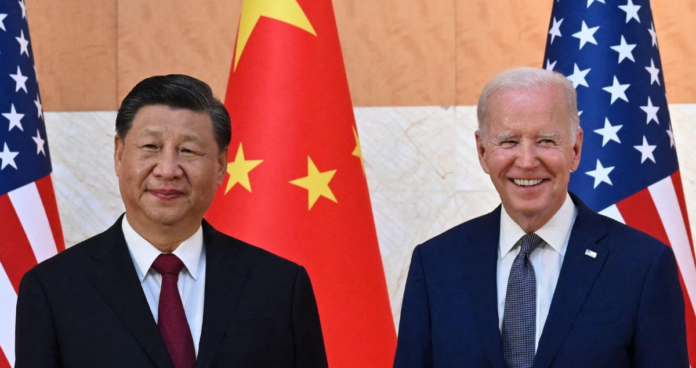Tom Crean, Socialist Alternative (ISA in the United States)
(This article was first published on 29 August 2023)
The last few years have seen a sharp rise in geopolitical tension centered on the US and China. This is being widely described as a New Cold War. What is at the root of this conflict?
While Joe Biden and the capitalist media in the US like to present this as a moral struggle between “democracy” and “dictatorship”, this is actually a clash between the two key imperialist powers in the world who are vying for control of global markets and resources.
Imperialism in our time is not primarily expressed in direct rule over other countries as it was in the era of colonialism though it is certainly about controlling access to the resources of Latin America, Africa, the Middle East, and large parts of Asia. Imperialist powers export capital and use their control of global finance to enforce dependence on “underdeveloped” parts of the world. The US has the International Monetary Fund and the World Bank while China has the Belt and Road initiative and their own global finance structure. Poor countries saddled with endless debt to the bloodsucking imperialist banks and institutions are often forced to cut spending on education and healthcare to keep the funds flowing and prevent economic collapse. Disastrous debt crises have impacted Sri Lanka, Pakistan, Zambia, and Argentina, among others, in the past couple of years.
The term “New” Cold War is also a reference to the original Cold War after World War II between the US and its allies on one side and the Soviet bloc countries on the other. This comparison has real limits. The original Cold War was a conflict between two social systems: capitalism and the planned economies ruled by Stalinist dictatorships. This conflict had many very “hot” phases like the Vietnam War but it also operated within certain limits. The conflict we are seeing today is more comparable to the period before World War I when British imperialism, the dominant world power of the time, was challenged by rising German imperialism.
The origins of the New Cold War
Even before the restoration of capitalism in China in the late 1980s, the US began to develop a close partnership with the Chinese regime, initially directed against the Stalinist regime in Russia. In the 1990s, China and the US became partners in the drive for a more globalized world economy.
But this development was still in the context of the US being the dominant, if weakened, global power. As the emerging new capitalist class in China began to assert itself and saw the possibility of expanding into a key and possibly dominant world power in its own right, the relationship frayed. By the 2010s, competition was increasingly the order of the day and the relationship turned much more adversarial with the rise of Xi Jinping in 2012 as head of the misnamed Chinese Communist Party particularly under Trump. This process has only accelerated under Biden.
Today, the rise of Chinese imperialism has stalled as the country faces major economic, social, and demographic crises. This does not mean, however, that the global conflict will fizzle out. In reality, we have two weakened, crisis-ridden imperialist powers fighting for dominance; this is a very dangerous dynamic with many consequences for working-class people around the world.
The age of disorder
The New Cold War is a central feature of the new era of disorder which has replaced the era of neoliberal globalization that existed for 40 years. The New Cold War is a driver of the process of deglobalization which is leading to the partial decoupling of the US and Chinese economies. The Biden administration has committed itself to “reshoring”, “nearshoring,” or “friend-shoring” industries that are vital to “national security” like semiconductor chip production. The CHIPS Act provides tens of billions for this purpose.
However, the US has gone further by placing restrictions on the sharing or sale of key technology with China and on investment by US capitalists in China. These are forms of economic warfare. China has retaliated with its own restrictions including cutting key US technology companies like Micron from major projects.
The New Cold War has also become “hot” in Ukraine. The Russian invasion last February has triggered the biggest war in Europe since World War II which has been subsumed into the wider global conflict. China quietly backs its ally Russia while the US and other NATO countries have poured tens of billions into arming the Ukrainian armed forces. The result has been to create a bloody World War I-style stalemate where the US estimates 500,000 soldiers on both sides have been killed or wounded.
The interests of the Ukrainian masses and their right to self-determination have nothing to do with US imperialism’s campaign. They have used the war to strengthen NATO not only against Russia but also China. The result is a rising wave of militarism from Germany to Japan. This includes massive increases in military spending which means less for housing, healthcare, education, or addressing the climate catastrophe. In fact, the war in Ukraine and the rise of militarism means a greater reliance on fossil fuel production.
Militarism also means the whipping up of reactionary nationalism which is poison to the workers’ movement. We have seen this in the US with the wave of attacks on Asian Americans under Trump and Biden.
The direction of travel
The key outcome of the past two years of escalation is a strengthening of the core of the US and China-led blocs. There are various developments that many observers thought unthinkable including Germany – which has very close economic ties with China – drawing up plans for partial decoupling. Another example is the new military alliance between the US, Japan, and South Korea which had to partially override deep enmity based on Japan’s brutal colonial occupation of Korea before and during World War II.
No part of the world is safe from the New Cold War as countries are pushed to take sides. As the accompanying article explains, the coup in Niger and the threat of war in central Africa cannot be separated from a new scramble for Africa by the US and China and their respective allies.
But the most dangerous flashpoint is the conflict over Taiwan and the South China Sea. The outcome of this will determine who dominates the Western Pacific in the world’s key economic region. The military buildup may not lead to war now or for some time but on the basis of the logic of imperialism, that is the direction.
Building an anti-imperialist movement
Again the clearest historical comparison to the current situation is the period before World War I. Many then thought that war between Germany and Britain was unthinkable. Nor will the presence of nuclear arsenals be enough to stop war today as we see in Ukraine where war on a massive scale has been unleashed without nuclear weapons being used – so far.
Imperialist conflict is the product of a capitalist social system in deep decline which cannot address the burning issues facing humanity including mass poverty and climate disaster. This is why we need to urgently build an international movement of workers and young people against militarism and the drive to war, a movement that consistently opposes all imperialism, especially “one’s own.”




